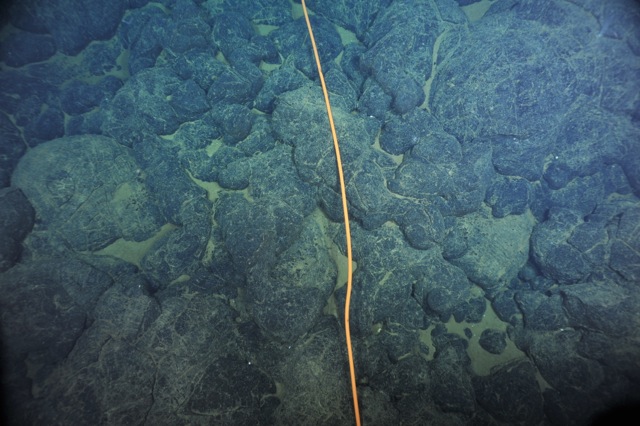Not long after completing the 18-hour transit from Newport OR to the Eastern Caldera site on Axial Seamount, the ROV ROPOS was successfully launched over the side of the R/V Thompson at 08:30 PDT on July 21. Attached to ROPOS was the bottom-pressure tilt (BOTPT) instrument that will measure small changes in the depth and tilt of the seafloor, changes that are indicative of inflation as magma rises in the volcano. Axial last erupted in April 2011 and is expected to erupt again in 8-10 years. Some inflation has already been measured since the last eruption.
The BOTPT is part of a “subnet” of instruments we are installing at the eastern summit of the Axial Caldera on Leg 3 of VISIONS ’13. This subnet also includes two short-period seismometers that can detect vibrations from small earthquakes ranging from 0.1 Hz to 100 Hz. Such earthquakes are caused by local phenomena, such as magma movement beneath Axial and the upward flow of hydrothermal fluids in the conduits that feed the black smoker chimneys. Over the next few days, the subnet cables and instruments will be installed using ROPOS. Although this subnet will not be plugged in this year to the primary infrastructure part of the regional cabled observatory, it will be tested during VISIONS ’13 when connected to the secondary cables with power and communications provided by the ROV.
After the BOTPT was released onto the seafloor by ROPOS, the ROV conducted an inspection survey of cable laid about one week earlier on Leg 2. The next step was to conduct surveys of proposed cable routes to fine-tune plans for the cable installation over Axial’s rough seafloor of glassy pillow basalts as well as smoother ropey lavas. Favorable locations for the subnet instrument installations were also identified.
Through all the ROV operations, students onboard Leg 3 have been standing 4-hour watches in the ROPOS control room, applying their training on the integrated real-time logging system (IRLS). IRLS includes features that organize, represent, search, and sort all activities performed by ROPOS, thus forming an invaluable repository of data, including photographs, such as the dusky rose-colored “dumbo” octopus spotted during Dive 1608 on July 22.
Contributed by Nancy Penrose, RSN Communications Coordinator


